I am discovering the importance of prayer and ritual in human existence. The TRUTH is alive and well on planet Earth. And we celebrated it this week with Galungan, one of Bali’s most auspicious festivals. Twice a year we mark the victory of Dharma (virtue) over Adharma (vice). During this holiday, the spirits of the Gods and the ancestors come down to visit the earthly plane. Balinese welcome them with prayers and offerings. For ten days the Gods return to earth for the festivities. On the last day, celebrations culminate with Kuningan, a day to say thank you and goodbye to Gods.
Galungan is a sacred ceremony that confers deep spiritual strength. It teaches the lesson of how to differentiate between Truth and Desire in the human soul. Even further, Galungan helps us to differentiate between the “Giant tendency of society” (asura sampad) and “Divine God tendency” (dewa sampad). We discover that to live happily means we must master the “Giant tendency”, which is essentially a distraction from God. The conclusion of Galungan is a powerful victory of Dharma over Adharma.
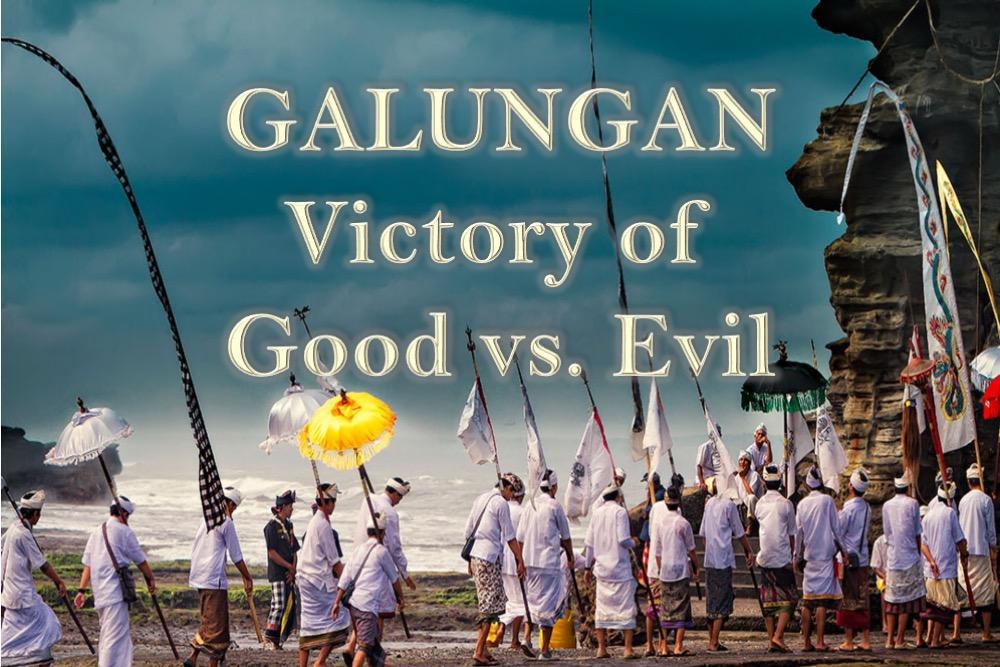
What do Dharma and Adharma mean?
These are often incorrectly translated as “Good vs. Evil”. When we look deeper, Dharma is a path of personal virtue. Adharma is a path toward vice or wrong-doing and negative attitude. We know Dharma and Adharma are always around us and inside us as possibilities. They represent our likes, dislikes, and tendencies.
Dharma is a direct path to enlightenment. It is your personal way of accumulating virtue to overcome your limitations and misunderstandings. Dharma is the purification path toward ascension, Moksha, or merging with God, which means you become free from the cycle of death and rebirth. Dharma is also related to your duty in life, your birth status, and selfless service. For example, the highest Dharma of a King is to rule righteously. However the Dharma of a honeybee is to make honey in the hive. Your highest Dharma path may be very different from mine. My lessons of Love and Acceptance will be different from yours. My soul needs to learn what is “Dark” vs. “Light” in relationship to every other experience in my past. We must all learn what it means to be weak vs. powerful, and how it feels to be the abused vs. abuser. The universe loves us so much that our lessons are very personalized. This is magic, and it explains why we cannot judge others.
Adharma is anything that leads you away from your highest path. It is not exactly “Evil”. It is just “not Dharma” i.e. not your highest path. Adharma is sometimes characterized as selfish desires, distracted by sensory impulses, or an unstable mind. Adharma is also seen as selfish, wicked, and harmful actions. However Adharma for one person is different from Adhama for another, therefore we need not judge others. Instead, we focus on building our own personal virtue.
Therefore, Galungan is a highly personal ceremony to honor each individual’s highest Dharma, and pray for personal victory over all lower tendencies.
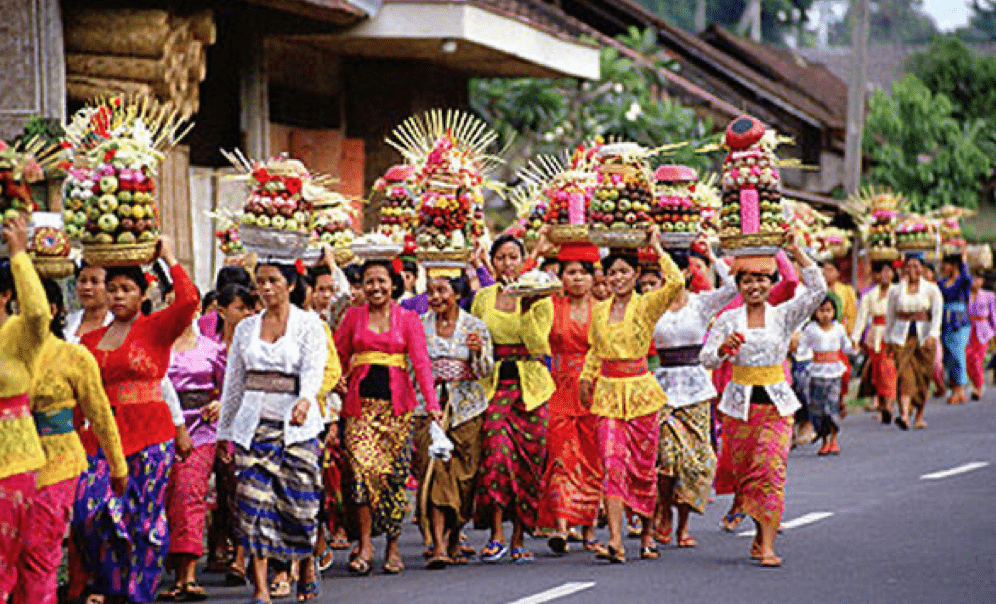
Balinese women are blessed with natural beauty and strength. Dressed in traditional clothes, they walk in a Galungan procession, carrying offerings of fruit and flowers in high baskets on their heads.

Many streets are filled with beautiful ‘Penjor’, tall bamboo poles decorated with intricate patterns of woven palm leaves aver a covered stand for offerings. Every home and building has their Penjor, and the patterns and colors are all unique.
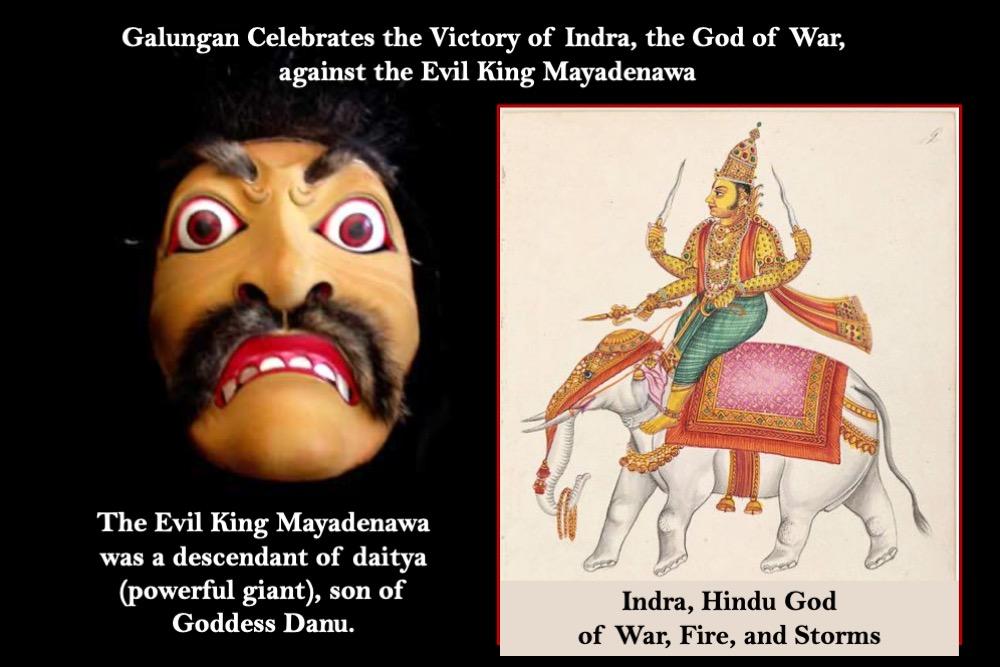
What is the Legend of Galungan?
Once upon a time, there was a terrible king, Mayadenawa, who ruled over Bali and other islands nearby. Mayadenawa was a descendant of the powerful giant daitya and the Goddess Danu. Because of his magical power, Mayadenawa could shape-shift into different creatures. His magical powers made Mayadenawa arrogant and evil. He cruelly destroyed all the shrines and temples. He forbade Balinese people to worship God, and told them to worship only him. He destroyed farms, causing hunger and disease. People suffered badly, but they did not have the strength to fight Mayadenawa’s multi-dimensional powers.
Mpu Kulputih, a powerful Hindu priest, observed all the people’s suffering. He went to meditate at the Mother Besakih Temple of Bali to ask for God s guidance. He received a revelation from the God Mahadewa that he should go to Jambu Dwipa (India) and ask for help. The story is not clear who went to India, but it was said that Indra, the God of War brought a huge army of warriors from heaven with powerful weapons to attack Mayadenawa.
The God Indra sent a special spy, Bhagawan Narada, to watch Mayadenawa Kingdom. But Mayadenawa discovered it and prepared his troops to face the attack. A dreadful war broke out, and many victims were killed on both sides. But the God Indra was much stronger, and Mayadenawa’s warriors ran away in fear. That night, when God Indra’s warriors slept, Mayadenawa created a terrible poisonous water fountain nearby. He ran away by walking with angled feet turned sideways in order to leave no footprints. This area is still called Tampaksiring, meaning “angled footprints”. The next day, Indra’s warriors drank from the poisoned waters and got very sick. To heal his warriors, God Indra created a different sacred spring with curing waters, called Tirta Empul (cleansing spring), which is still flowing in Bali. The holy spring flowed created a river Tukad Pakerisan, known as Pakerisan River.
Indra’s warriors chased after Mayadenawa, but he disguised himself into other shapes. First a manuk raya (big bird), then a plant buah timbul, and then a busung (young coconut leaf), and a dewata (goddess). Lastly, Mayadenawa transformed himself into a huge rock. God Indra shot him dead with an arrow. The flow of his blood created a huge river called Tukad Petanu (Petanu River). It was believed that the river was cursed, because if it was used to irrigate rice fields, blood would come out of the paddies and they stank. This curse lasted 1000 years.
The end of the war and the death of Mayadenawa was celebrated as the victory of goodness (dharma) against vice (adharma). This triumphant day is commemorated every six months (210 days) of Balinese almanac. It is called Galungan, because it is occurred on the day wuku Galungan of the Balinese calendar.
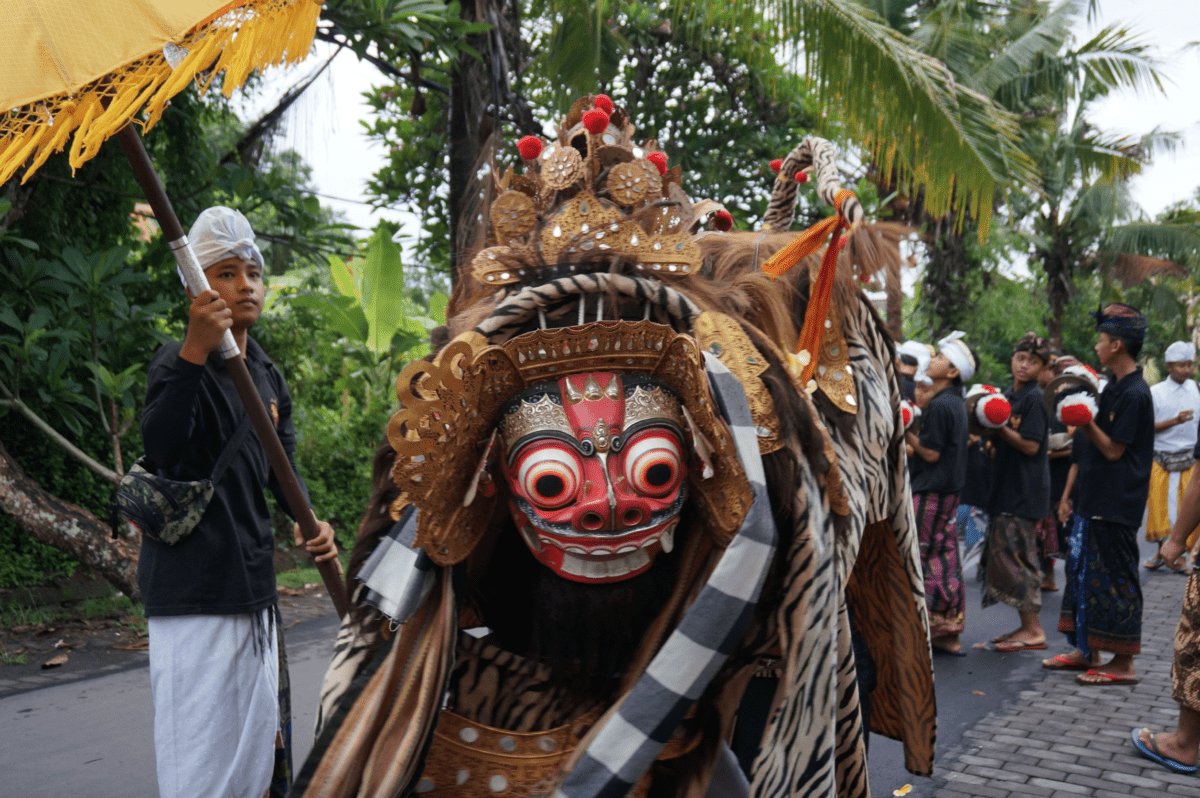
Exorcism Dance of the Barong
In traditional villages, the ceremony of Ngelawang is performed by a Barong to drive away wicked spirits. Ngelawang is an exorcism ritual performed by a Barong,a divine protector in the form of a mythical beast. The Barong is invited from house to house, making his way through the village. His dance is meant to restore the balance of good and evil in each house. The residents of each home offer prayers to the dancing beast. The the mythical beast gives a piece of his fur as a keepsake, and receives a beautiful “Canang Sari” arrangement of flowers containing money.
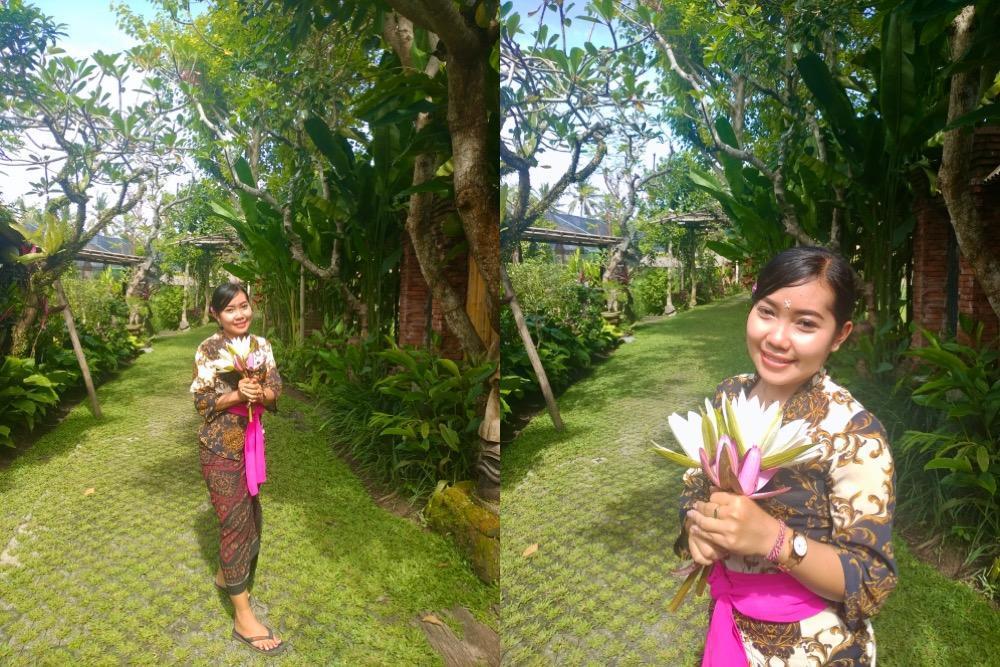
Our lovely friend Putu, on the staff of Keramas Sacred River Village, does the Galungan blessing today.
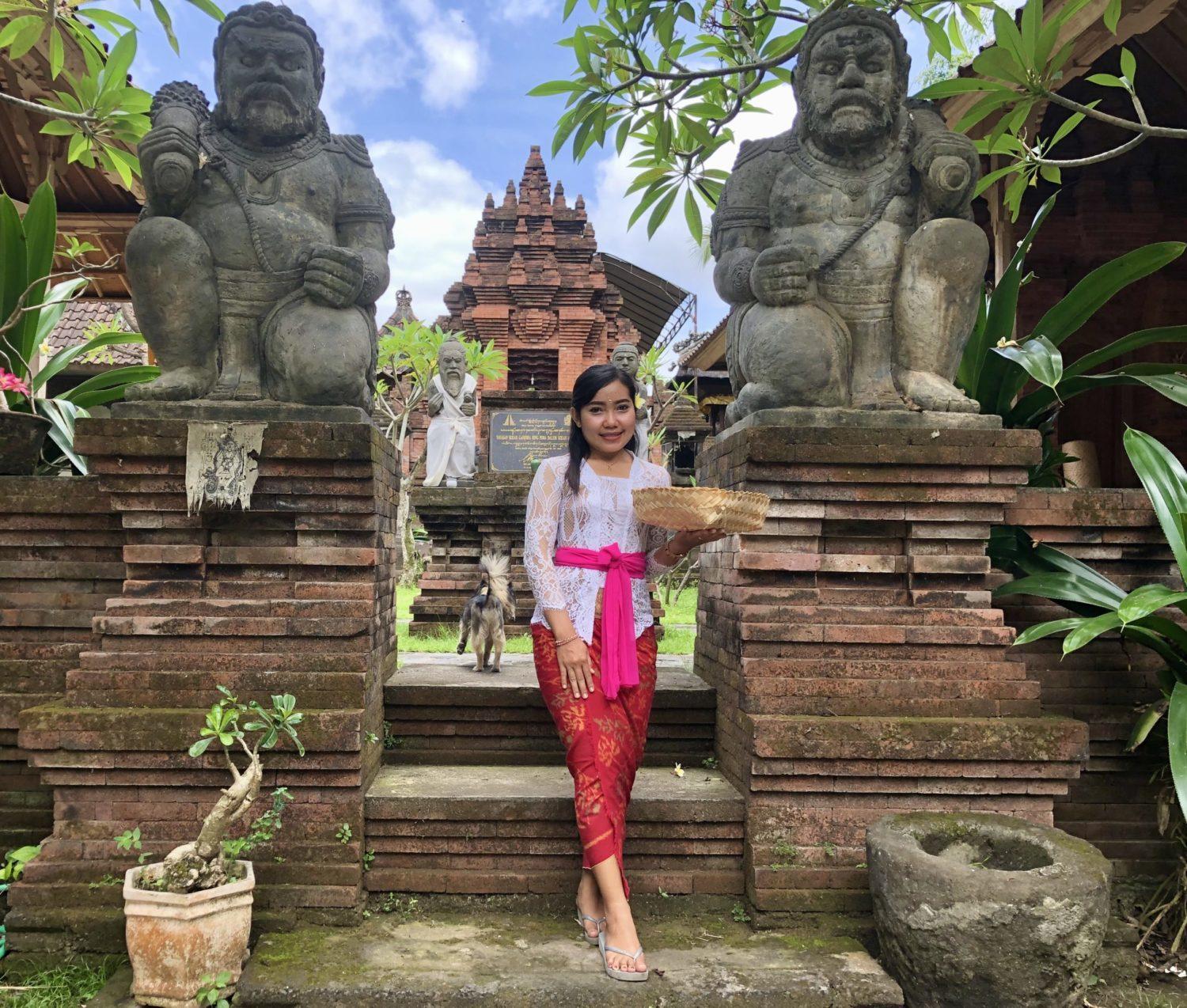
Galungan preparations begin several days beforehand:
- Penyekeban: Three days before Galungan, families begin their preparations with “Penyekeban”, which means “the day to cover up”, when green bananas are covered in huge clay pots to ripen faster.
- Penyajahan: Two days beforehand is a quiet time of introspection for Balinese and a time to make the Balinese cakes known as “jaja”. These colored cakes made of fried rice dough are used in offerings especially on Galungan.
- Penampahan: The day before Galungan is slaughter day. On this day, Balinese harvest the sacrificial animals for the temple offerings. Many special foods are prepared, such as lawar spicy pork and satay.
- Galungan Day: Prayers start very early in the morning, as families go to the temples to make offerings to the spirits. Women carry offerings on their heads. Men bring ‘Penjor’ palm decorations.
- The Day After Galungan: Everyone visits extended families and close friends.
- Kuningan: The tenth day after Galungan Day marks the end of Galungan period. Kuningan is believed to be the day when the spirits ascend back to heaven.
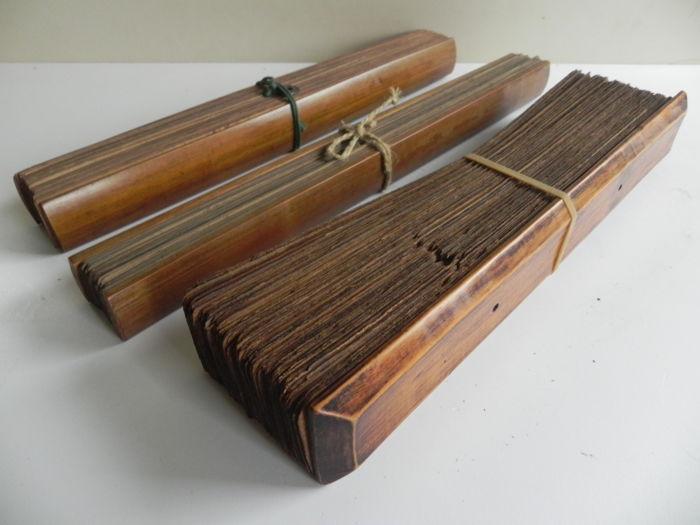
Balinese use specially prepared palm leaves called “Lontar” instead of paper to record important events. Every community used Lontar to record important battles, events, births, deaths, marriages, and to immortalize literary works. The Lontar are inscribed with a special sharp tool made of iron called a “Penjerupak”.
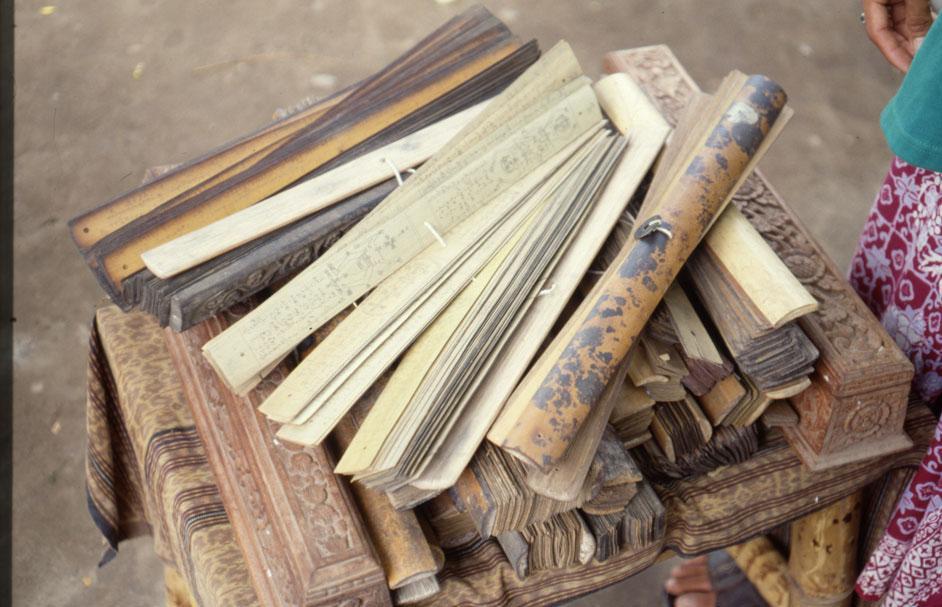
When was the First Galungan Celebrated? We Can Ask the Lontar Palm Leaf Records!
According to the ancient “Purana Bali Dwipa Lontar scripture”, the first Galungan was celebrated in Bali on the fourth full moon of Kapat in the year 804 of the Balinese Hindu Saka calendar. It was inscribed on the ancient palm leaves. That was the year 882 in our Gregorian calendar, which was 1,139 years ago!
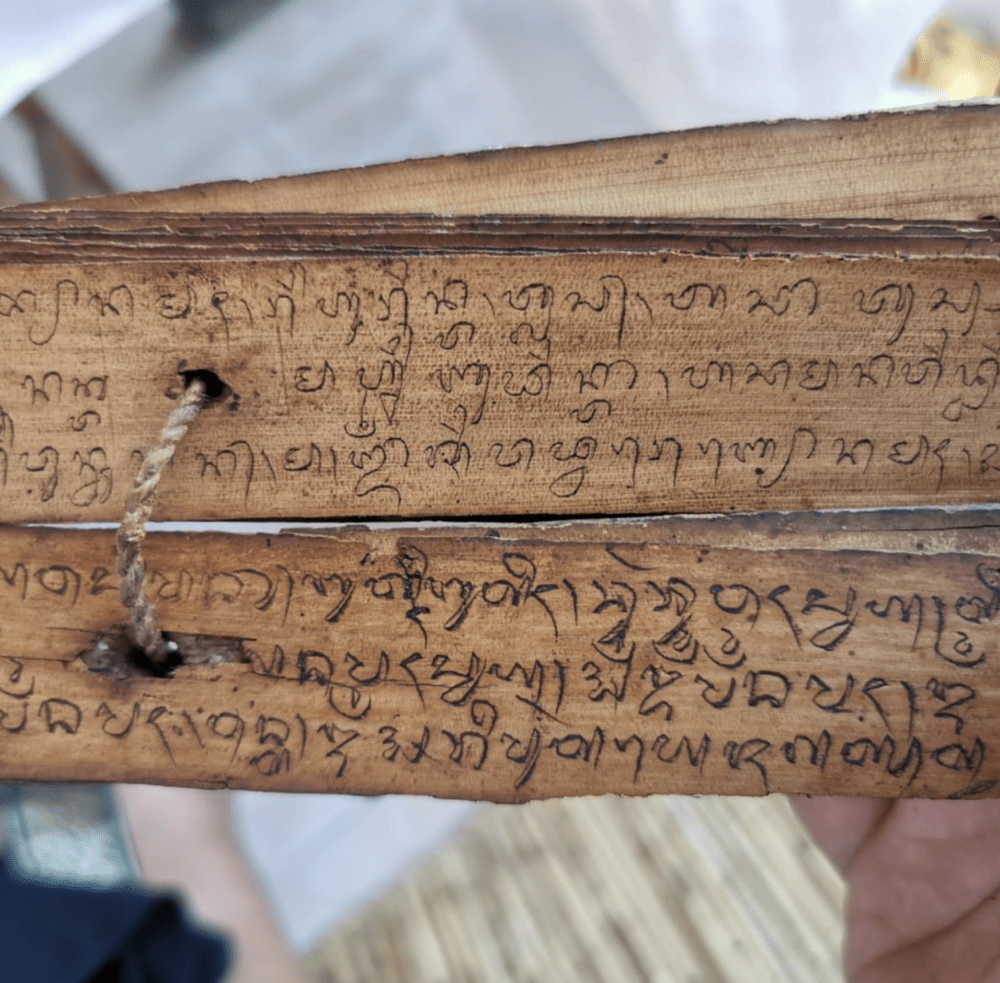
Recently there is a revival of interest in the Lontar tradition. Inscribing sacred texts in the ancient script onto palm leaves is a great way to study and absorb scriptural wisdom. Many people perform it as a prayerful penance to gain virtue and knowledge.
Lontar palm leaf inscriptions are used for many purposes:
- Geneological records: births, deaths, marriages, and family lineages.
- Holy books, written in old Javanese, Sanskrit, and Balinese.
- Regulations, laws, rules, morals and ethics.
- Traditional homeopathy and healing techniques.
- Astronomy, Astrology, Spiritual sciences, language, and mythology.
- Shadow Puppet Plays, Epic prose, Classical stories, and poems
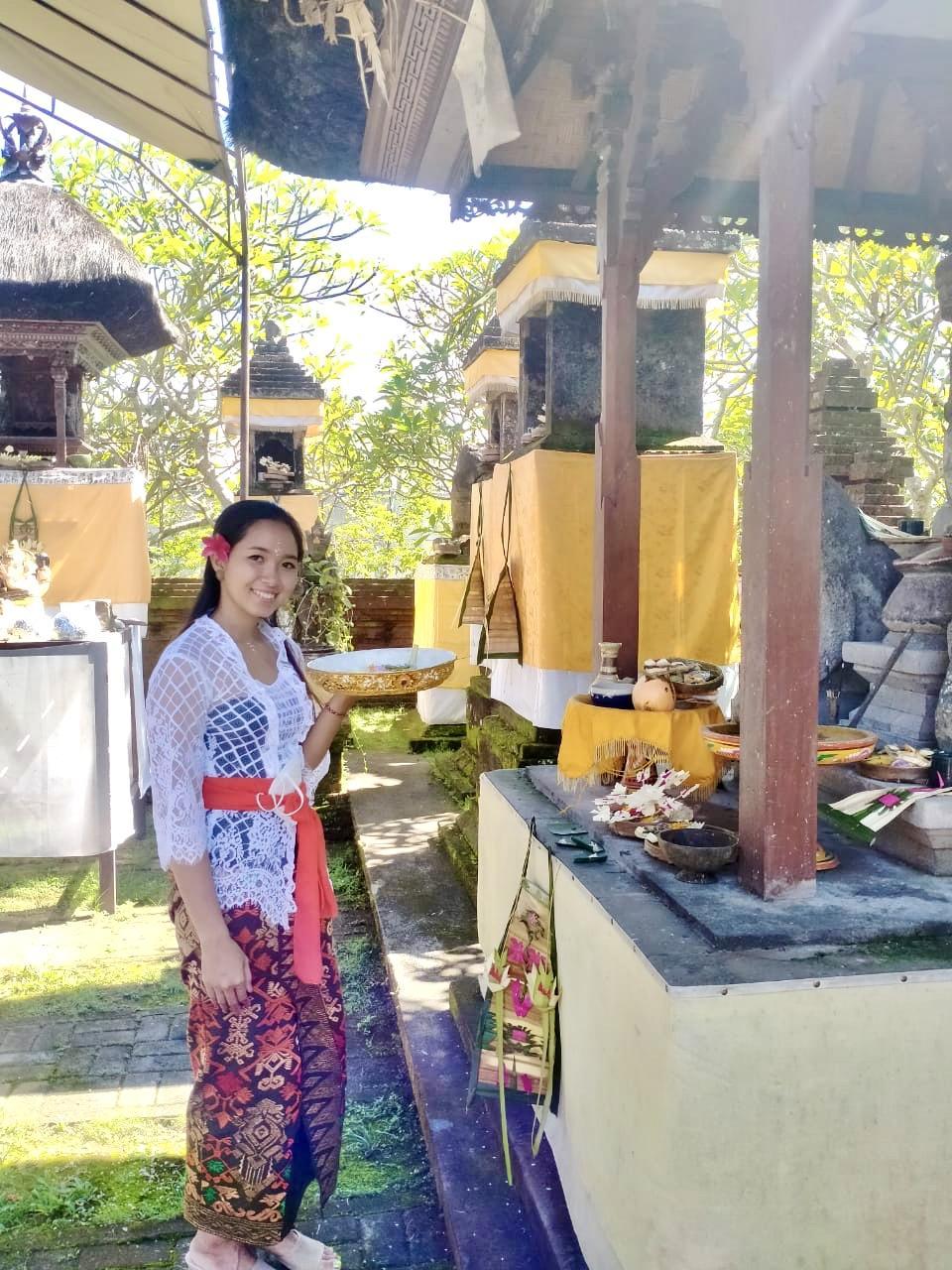
This is Kadek making the Galungan blessing early in the morning.
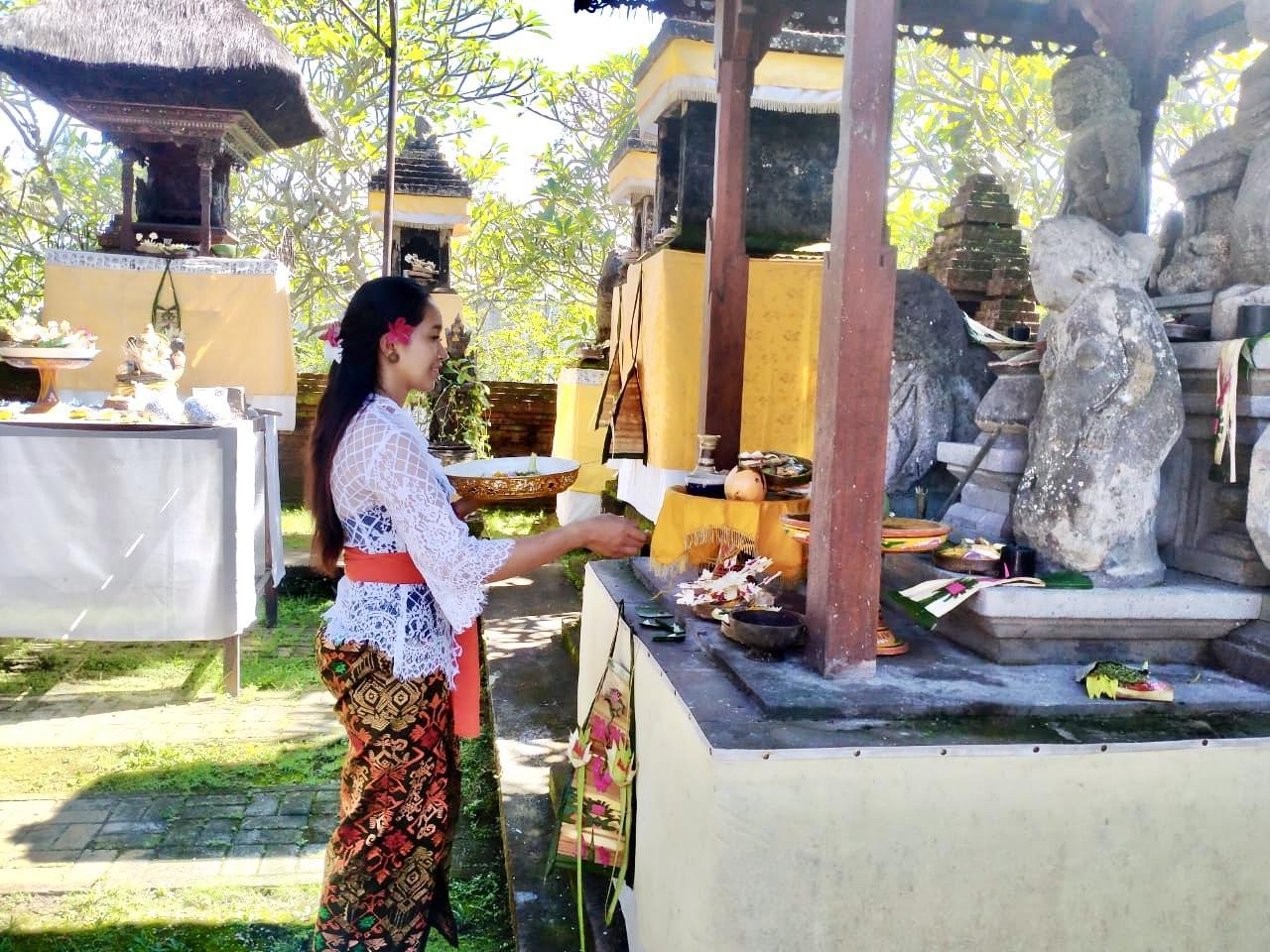
This is our private 7th-century temple at Keramas Sacred River Village.
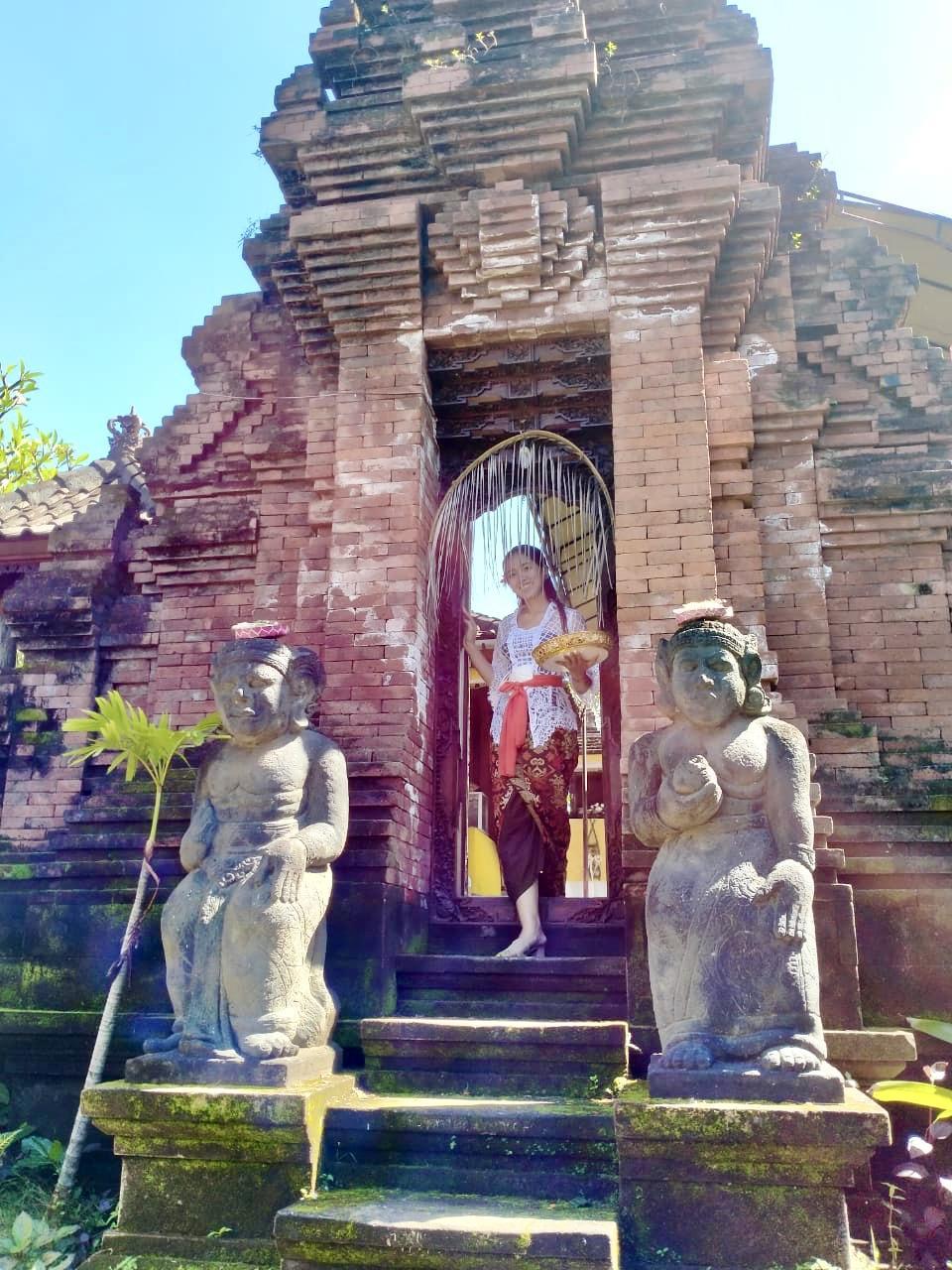
Kadek is finishing the blessing.
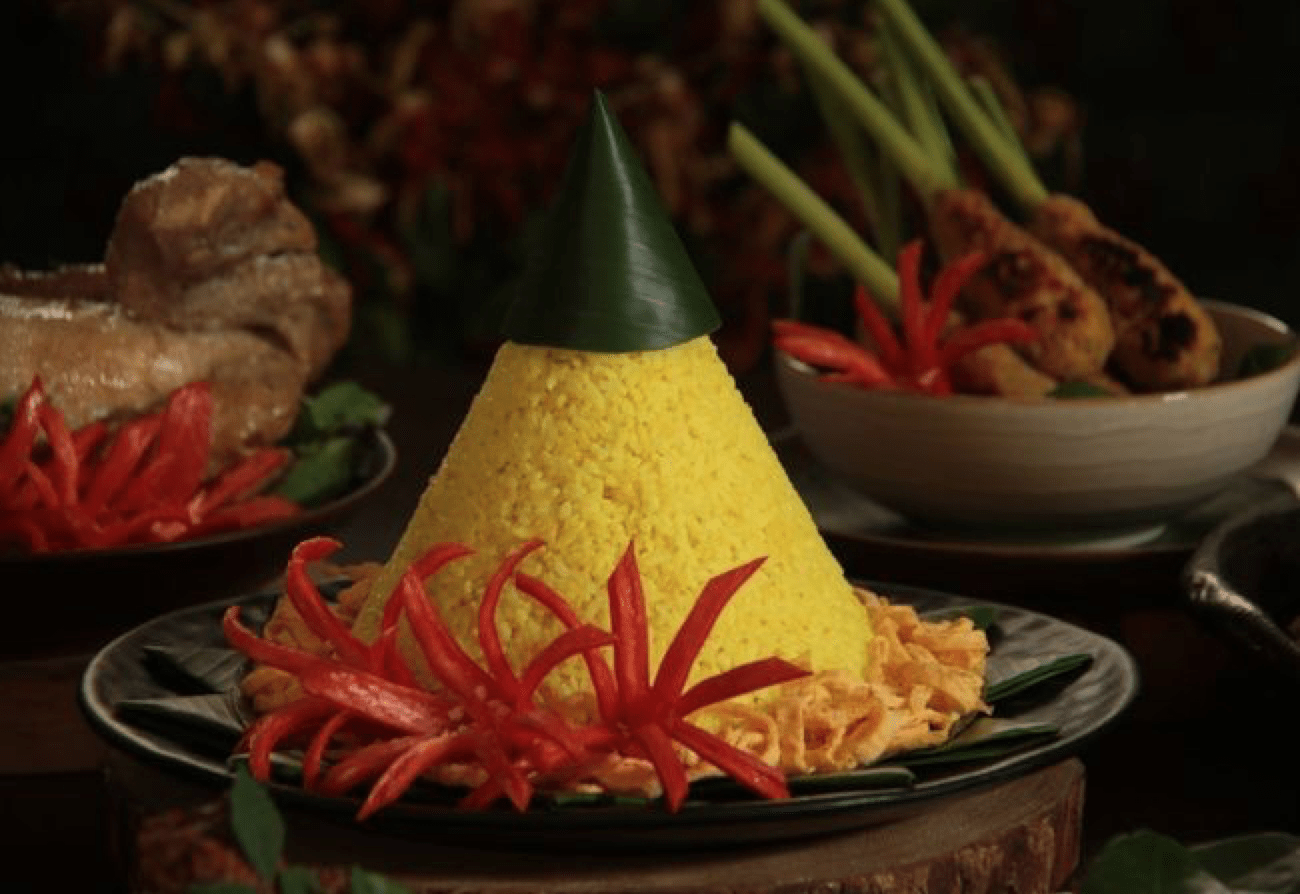
The very last day we celebrate Kuningan. The word Kuningan means “Yellow”. Today Balinese make special offerings of yellow rice with turmeric, called “Nasi Kuning”. Yellow rice symbolizes a pile of gold, good fortune, prosperity, and wealth. Sate and chicken are also favorite dishes.
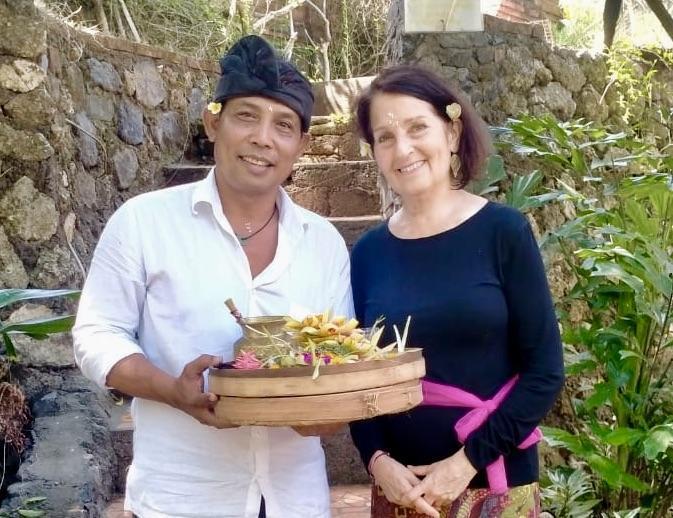
Thanks for stopping by!
And best wishes!
Sri Jana
About me:
I am Sri Jana, aka Jane Barthelemy, intuitive medium, channel, author, energy healer and a devout Christian, Buddhist, Hindu, Taoist. I was born in Minnesota, USA, baptized Catholic. As a I child questioned Original Sin and Catechism teachings that my Presbyterian mother could never go to Heaven. I have practiced Kundalini and Buddhist meditation for over 50 years. I have an MBA and worked as CFO of Rudi’s Bakery for 10 years. My life path followed many careers, as an opera primadonna in Italy, and owner of a Venetian glass jewelry company. Serious health challenges led me to teach Qigong, Taichi, and to write two healthy cookbooks: “Paleo Desserts” and “Good Morning Paleo”. My upcoming books include: “Heal Your Past Lives”, and “Buddha Speaks – Channeled Passages from the Master”. I live in Bali with my Bhutanese husband Lama D. We offer classes, retreats, healings, past life clearings, and kundalini meditations. My website is FiveSeasonsMedicine.com.


